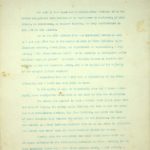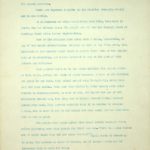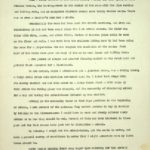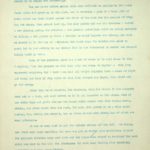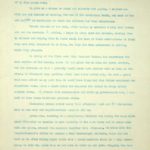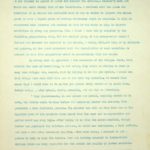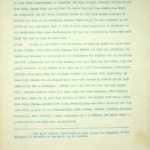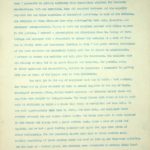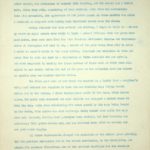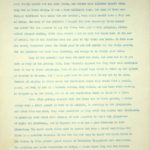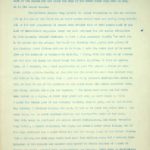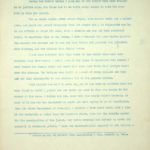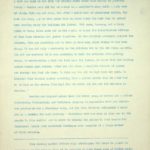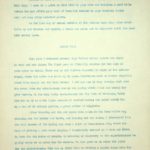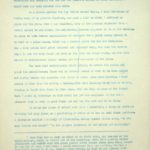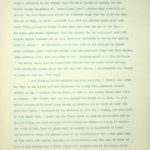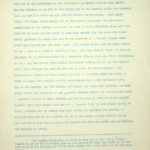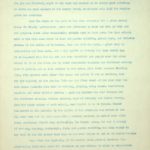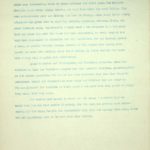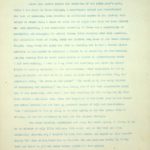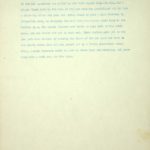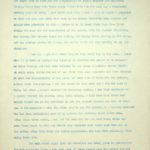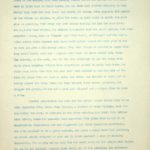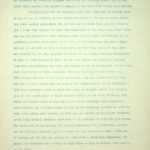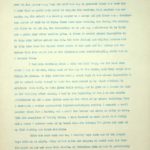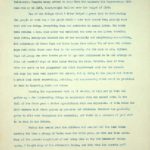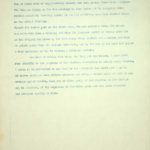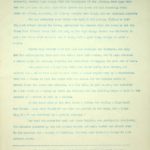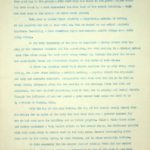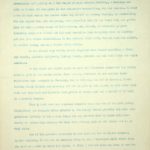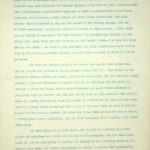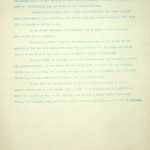Pine Mountain Settlement School
Series 09: BIOGRAPHY – Students
Series 19: Students
WILLIAM TAYLOR BROWN Teacher Narrative
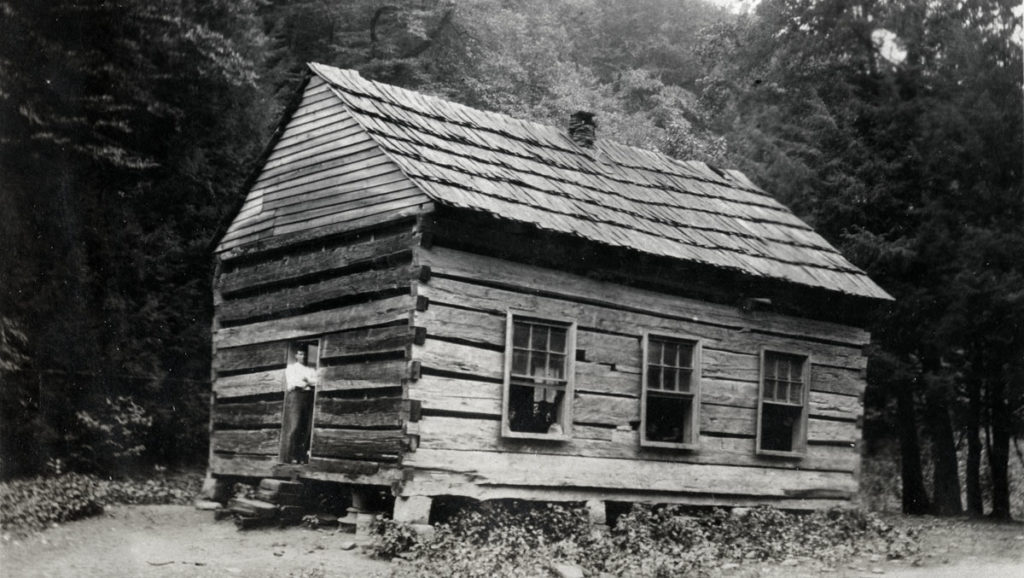
TAGS: W. Taylor Brown, narrative, rural schools, Berea College normal classes, Harlan County, community families, education, Pine Mountain Settlement School, religion, log schoolhouses, school superintendents, school supplies, hookworm, school library, holiday programs, schoolhouse heating systems, Sunday school, clean drinking water, school fairs, Lucretia Garfield, fundraising, Rose Brown, William Brown,
WILLIAM TAYLOR BROWN Teacher Narrative 1922-26
William Taylor Brown was a Berea College Normal School graduate and a friend of Katherine Pettit, a Founder and Director of Pine Mountain Settlement School (PMSS) in Harlan County, Kentucky. He was strongly influenced by Pettit and by her commitment to education in the Eastern Kentucky mountains. He also shows the same educational “can-do” attitude that made Pettit’s efforts at Pine Mountain so extraordinarily successful in the second decade of the twentieth century.
WILLIAM TAYLOR BROWN TEACHER NARRATIVE, describes his extraordinary four years as a teacher at the primitive Green Hill School, near Pine Mountain Settlement. The one-room school-house in the Pine Mountain Valley in Harlan County, Kentucky was ill-prepared to offer any semblance of a “school” much less an education. During the school years of 1922-1923 through 1925-1926 Brown was successful in re-shaping the school, the lives of many families in the narrow valley and, to a degree, the educational climate of Harlan County. In its many hollows and through his extraordinarily innovative work as a teacher, innovative social worker, agriculturalist, carpenter, hygienist, and community member, Brown’s work will inspire any reader.
As a friend of Katherine Pettit. William Taylor Brown was a follower of Pettit’s educational reform goals. He also assisted his half-siblings, William and Rose Brown, to attend PMSS in 1928-1929, and was unusually prepared and remarkably successful in addressing the difficult tasks he faced in raising the regional community educational levels.
This page consists of a list of contents of his narrative, a full transcription, and images of the typescript document.
William Taylor Brown said of his work to build up the physical fitness of the school and to teach at the Green Hill School near Pine Mountain —
It has been my aim throughout my four years’ work not only to have a better school, but to work things over is such a way that it will be possible to teach the adults as well as the children how to make a better living from their farms, have better homes, churches, Sunday Schools, and better social life in general.
This is the story of how he did just that and more.
CONTENTS: WILLIAM TAYLOR BROWN Narrative 1922-26
FIRST SCHOOL YEAR – 1922-1923: W. Taylor Brown Narrative
[029] Page 01 – taking normal classes of Berea College; describing school location and community
[030] Page 02 – using school-house for church services; describing families, problems with isolation, attitudes toward schooling, subsistence farming, and log homes
[031] Page 03 – hospitable and courteous people; enjoying shooting-matches; describing their religions; Holiness Movement members and Baptists; describing conditions of the school grounds and building
[032] Page 04 – surveying dilapidated conditions; re-locating voting place; meetings with patrons
[033] Page 05 – students are “hungry for leadership”; trustee’s visit; cleaning up building and grounds by students
[034] Page 06 – the first week; recitations; seating; Miss Marguerite Butler; visiting the superintendent, Mr. Jones; securing lumber;
[036] Page 08 – repairing the desks; building the toilets
[037] Page 09 – hookworm tests and treatments, with advice from Dr. Cowley, Berea College; building cabinets and a lunch pail rack
[038] Page 10 – starting a school library; receiving book donations; building a drinking cup rack; acquiring textbooks
[039] Page 11 – acquiring text books; handling student discipline; clearing the playground of stones
[040] Page 12 – hauling coal; purchasing schoolroom supplies
[041] Page 13 – acquiring window guards; getting foot bridges built by county; improving the coal stove
[042] Page 14 – improving the coal stove; planning Thanksgiving and Christmas programs; receiving presents from PMSS
[043] Page 15 – teaching baseball; meeting with patrons;
SECOND SCHOOL YEAR – 1923-1924: W. Taylor Brown Narrative
cleaning up the spring for drinking water
[044] Page 16 – hauling cement and paint; arranging a Sunday school; cementing the spring; painting the school-house; advantages of improved heating system
[045] Page 17 – researching methods to improve the school; working on the spring; county board payments; building a bridge over the creek
[046] Page 18 – painting the schoolhouse exterior grey and the interior sea green and ivory
[047] Page 19 – arranging a joint school fair, assisted by the County Agricultural Agent; contests, spelling bees, displays, dinner; arrival of students from neighboring districts
[048] Page 20 – operation of the library and its influence on the students; planning Thanksgiving and Christmas programs assisted by Miss Lucretia Garfield from PMSS.
THIRD SCHOOL YEAR – 1924-1925: W. Taylor Brown Narrative
[049] Page 21 – receiving additional students from a discontinued school; acquiring timber from Fred M. Sackett to remodel and enlarge the schoolhouse; receiving free service from sawmill owner and school trustee C.A.(?) Nolan; acquiring money from the county board
050] Page 22 – remodeling and enlarging the schoolhouse
[051] Page 23 – seeking help from the community men; dealing with opposition to the plan
[052] Page 24 – preparing land for a playground and the community fair; preparing for the second annual school fair
MISSING PAGE 25
[053] Page 26 – installing schoolhouse’s slate roof; Miss Dingman’s fundraising at Berea College and help with teaching
[054] Page 27 – adding windows doors, ceiling, floor, stairway, and tin siding to extension; creating a sleeping room in the schoolhouse attic
[055] Page 28 – cost of the improvements; calculating the hours of free labor by man, mule, and team; organizing a Junior Agricultural Club during first year; needing advanced books in third year
[056] Page 29 – receiving textbooks from Berea College training school, totaling 400 books in library; creating a literary society in the third year; describing advances in school work by third year
FOURTH SCHOOL YEAR – 1925-1926: W. Taylor Brown Narrative
[057] Page 30 – sawing and milling logs by community; finishing work on the new extension; extending the yard around the building by building a new fence; enclosing the basement; putting together a school bell, tower, and flagstaff
[058] Page 31 – making walkways with flat stones; working on school projects with his sister (Rose?), who began teaching nearby; arranging for Mr. Deedrick to hold church services and Sunday school at the schoolhouse; receiving donation of an organ from an Ohio church; holding the Second Annual School Fair, including a baby health clinic, student contests, and talks
[059] Page 32 – conducting box suppers in four schools to raise funds; purchasing new supplies; using the Volunteer System for routine schoolroom jobs; the resultant progressiveness of the school after “hard work and constant endeavor”; dealing with moonshiners; benefits, now and in the future, of the improved school building; acquiring of Green Hill by Red Bird Settlement; describing his aim throughout his four years’ work, not only for a better school, but to teach both adults and children how to live better.
See Also:
WILLIAM AND ROSE BROWN Students (Biography)
WILLIAM AND ROSE BROWN Correspondence (1928-1929)
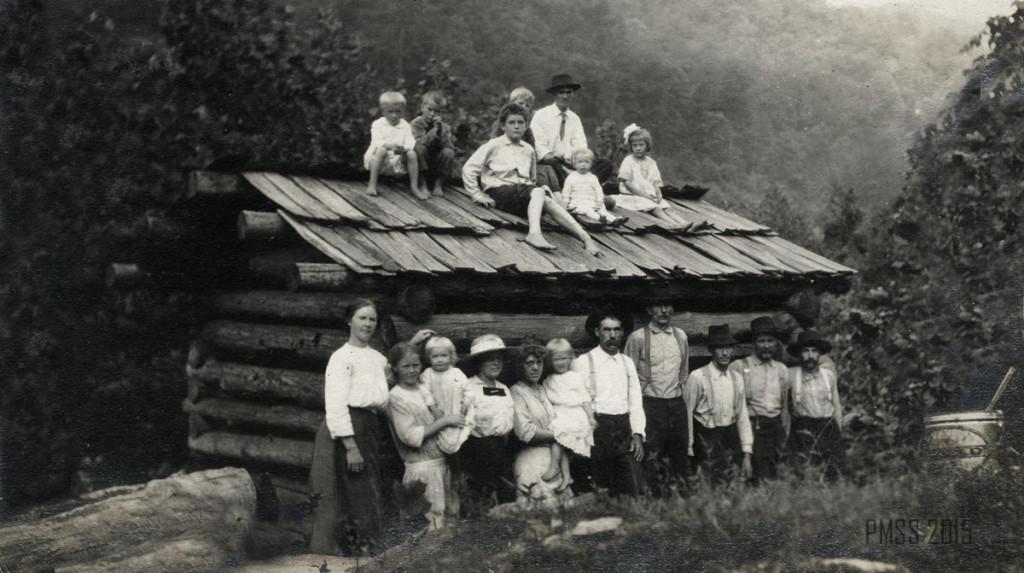
TRANSCRIPTION: WILLIAM TAYLOR BROWN Narrative
NOTE: This 34-page document is located in the PMSS Collections and consists of carbon copies of a typewritten text. The text has been slightly edited for clarity.
[028] Page 00 BLANK PAGE
[029] Page 01
Far back in the mountains of southeastern Kentucky stood the little dilapidated school-house of my boyhood — no playground, no out-houses, no trained teacher, and only indifference on the part of parents.
And it was this picture that was constantly before my mind as I sat day after day in the normal classes of Berea College. As we discussed methods, discipline, and improvement of communities, I kept asking, “Will those methods work?” “Is it possible to discipline undisciplined boys and girls?” “Is there a fighting chance to improve such schools as the one described above, for it is typical of the majority of the schools in this section?”
I determined that if I ever had an opportunity to try these principles out I would see what could be done.
In the spring of 1922 my opportunity came and I chose a community some twenty-five miles from my old home to make the experiment.
The school was located in Harlan County about eight miles from the town of Harlan, the county seat. This may not seem so far but there was that conspicuous barrier, big Pine Mountain, and about six miles of rough mountain road between the school and the railroad. The school was located in a very isolated district shut in on all sides by mountains and having only creek beds and rough mountain trails for roads.
Passing down the main creek one would think there would not be enough children in the surrounding territory to make a school, but in this community there was a fair-sized general store, a post office, a grist mill, a small saw mill, a blacksmith shop, and a Masonic lodge hall.
[030] Page 02
There was no regular church building, the school-house being used for the church services.
There are eighteen families in the district averaging nearly six to the family.
As in hundreds of other mountainous districts, isolation is having its bad effects here. The people are all related through blood or marriage which tends toward degeneration.
Most of the children have never seen a train, automobile, or any of the modern conveniences. Probably as much as any thing else, this ignorance of the outside world tends to narrow their view of the advantages of an education, and causes interest to lag on the part of both parents and children.
Some parents hesitate to buy their children the proper number of text books, giving all kinds of minor excuses. As soon as the children are grown to any size, they attend school very irregularly, being kept away from home duties. This puts them behind in their school work which results in discouragement. As soon as they are beyond the age of the compulsory school law, they drop out of school without having accomplished very much. Many parents maintain that it is useless to educate a girl, for as soon as she is old enough she will marry and her education will do her no good.
The people make their living from rough little mountain farms seldom producing more than enough for their own use. There is a good market six or eight miles away but the steep mountain trail makes it necessary to carry the produce on mules or horses, and it takes a whole day of strenuous toil to make the trip.
Most of the people live in rough little two-room log houses with sometimes a side room made of split boards for a kitchen and a dining room.
[031] Page 03
In their homes they are very generous and hospitable, treating their guests with all the courtesy and pomp that they know and can afford.
Of all sports I think the men enjoy “shooting-matches” most. When the weather is suitable for killing animals, they will gather on Saturdays at an appointed place for the match. Each one pays the owner so much a shot and the one who hits nearest the mark wins the prize.
In religion the people are very badly divided. Some are members of the Holiness Movement and others, the Baptist church. As a rule they refuse to worship together. This condition makes it difficult to have Sunday school or do any kind of cooperative community work.
The school-house was located in a level bottom, enclosed in a small lot about forty by sixty feet. The house being located so near the creek and the road made it difficult to keep the children out of the water and from looking toward the road when people were passing. Except for the small school-yard there was at first no playground provided, but there did happen to be a narrow strip of ground between an adjacent garden fence and the creek. This was covered with shrubbery and rocks so that it was unfit for a playground.
The school-house was a small one-room framed building about twenty by thirty feet, storm sheeted inside and out. The storm sheeting was covered with imitation brick siding on the outside and imitation ceiling on the inside. It had three windows on each side and a door in the end next to the road. Having been painted with a red, wood-paint on the outside, it had begun to scale off and leave the tin exposed to the weather. On the inside the room was painted brown, very poor taste for a school-building.
Considering the site, the painting, and the construction of this school plant, we are reminded of the ignorance or carelessness of those who had the work in charge However, this school was typical of hundreds of other rural schools to be found in the mountains.
[032] Page 04
When I first arrived at the school-house, I found the door open, several windows broken, the heating-stove in the center of the room with the pipe rusting and falling down, and no equipment whatever except some twenty double seats. There was not even a teacher’s desk nor a chair.
Occasionally the room had been used for church services, and from all indications it had not been swept since the last school closed. The floor was thick with dirt, paper, and other filth. Stains of tobacco juice could be seen on the floor and wall. I was told that the children living near by had been using the room for a play-house. One can imagine the condition of the seats. About half of the desks were gone and many of the seats were loose and falling down.
A few pieces of tongue and grooved flooring nailed on the front wall and painted black answered for a black board.
In one corner, where I afterwards put a jacketed stove, was a voting booth, a large metal frame with curtains stretched upon it. I later took steps with the county sheriff and had this moved to a lodge house about a mile away. By this action the voting place was changed, and the necessity of dismissing school for a day and having the school-house littered up was avoided.
Arriving in the community three or four days previous to the beginning of school, I met several of the patrons. They seemed anxious to try my courage by telling me the circumstances I would have to meet and freely offered their advice as to how they should be met. Several of them had been trustees in times past and for that reason knew just how to discipline a school.
On Saturday I swept out the school-house, put the seats in order, and made a general survey of conditions in order that I might ascertain what my first moves(?) should be.
Early Monday morning found many eager eyes watching for the arrival of their new teacher. All the children seemed to be curious to know what would be said and done. Keen interest was manifest from the very first and they all
[033] Page 05
seemed to be hungry for leadership.
The two hours before school time were utilized in pulling up the large weeds which had grown up in the yard, and in removing a part of a huge pile of rocks which had been placed across the front of the yard for the purpose of keeping out stock. When school took up, the only patron out was the trustee. I talked a few minutes giving the children a few general principles which we should endeavor to follow, a few points by which I thought we could improve our school, and what we should do in the way of a clean-up the first day. The trustee was asked to speak but he had nothing to say except that he was interest in school and thought things would go well.
Some of the children asked for a set of rules to be laid down. To this I replied, “for the present we will have only one rule. Be right.” At this they express surprise, but I told them that all bright children have a sense of right and wrong and that if they would do what they thought was right, they would not go far wrong.
After this brief session the students, from the oldest to the youngest, were set to a task, and each worked as if it all depended on him alone. Some of the older boys and girls cleaned the house while others were busy taking rocks, sticks, and other trash from the yard. The rock pile proved to be a fine snake harbor, for, during its removal, two or three snakes were found, one of which was very poisonous.
It was no easy task to get the tobacco stains off the floor and walls, but after much hard scrubbing the room was put in fairly good condition. At noon the smallest children were sent home and the large ones stayed to continue the work which was kept up far into the afternoon. All went home feeling that something worthwhile had been accomplished.
It was a late hour that night before I ceased to study schedules and plans to be put into effect within the next few days(?).
[034] Page 06
The first week was, I believe, the hardest and most discouraging week of my four years’ work.
To give me a chance to study and classify the pupils, I started out with the old methods of seating, the use of the recitation bench, and some of the old methods of recitation to which the children had been accustomed.
Toward the end of the week after having my schedule fairly well worked out and the students classified, I began to adopt some new methods, seating them by classes and keeping them in their seats for most of their recitations. At first they were very reluctant to do this, for they had been accustomed to sitting where they pleased.
On Friday of the first week, Miss Marguerite Butler, the supervisor for that section of the county, came. All was gloom for me when she first arrived, but she informed me that I probably would never have another week so hard as the first. We discussed many problems which were later worked out, but with a great deal more effort on my part than it would have taken had Miss Butler continued her supervisor work. About a month later she departed for Europe to study school systems there. Without that enthusiastic aid which my predecessors had, I was left to face these difficult problems alone.
Dismissing school rather early that afternoon I set out for the county seat to see what the superintendent could do for us.
A young man, teaching in a neighboring district, was facing the same difficult situation as myself. We were boarding at the same house and in accordance with our plans, crossed the mountain together that afternoon. On going into the superintendent’s office we assumed a very discouraged attitude, which was not hard to do after hiking eight miles over a rough mountain trail on a July afternoon. We told Mr. Jones that we had come to throw up our jobs. Dropping his head he began to think seriously. Soon a chuckle from us gave him to know that we were only teasing.
[035] Page 07
At our request he agreed to order for each of the schools, a teacher’s desk and chair and about twenty feet of new blackboard. I reviewed with Mr. Jones the condition of my school and intimated that it was my desire to improve the school plant so that a higher grade of working efficiency might be obtained. To this he manifested keen interest and assured me that he was ready to help to improve conditions in every way possible. Then I think I took him by surprise by the following proposition; that, for the smaller jobs, if the county-board would furnish and deliver the material to the school, I would, with the help of my students and patrons, do the labor connected with the installation of such material. He assured me that this proposition would be satisfactory with the board.
By making such an agreement I was conscious of two things. First, that without the cost of installing to the board, they would be willing to send us many more things; and, second, that by helping to do the job myself, I could see that things were done with care and in the best way possible. Of course, this meant that I would have to be on the job almost every minute of my spare time, before school, after school, during recesses, and all day on Saturdays.
*Many improvements, in and around the school, urgently need to be made, but little could be done before the necessary lumber was secured. This presented a most difficult problem. The closest saw mill at that time was on the opposite side of the mountain which meant that the cost and transportation together would run very high. After taking it up with the superintendent, enough lumber was purchased for thirteen dollars, to build two out-houses, a book cabinet, and make a few other necessary repairs. After some delay, I managed to get a patron to help me haul the lumber. Cost and hauling amounted to twenty-three dollars which was very expensive for the amount and quality of lumber received.
——————————————————————————————————————————-*So far as possible, the different improvements will be mentioned in chronological order.
[036] Page 08
In the meantime, with the help of the largest boys, I had been making as many other improvements as possible. The boys brought ordinary roofing boards from home, planed them and repaired the desks that had been destroyed. Those who originally put the desks together seemed to have been rather careless in leaving out many of the necessary screws. These we put in and tightened up the others so that the seats were at last in good solid condition. We converted an old recitation bench into chalk-troughs for our new blackboards. These were well worth the time it took to make them.*
As soon as our lumber was delivered, we began to spend our spare time on the toilets which were badly needed. When school was over one afternoon, the lumber was measured up according to the dimensions the toilets were to be built, and with a cross-cut saw the next morning, the boys soon cut the lumber into its proper lengths. We had little to do then but to nail them together. While these patterns were being cut, the children watched the process with eagerness, and, from their remarks it was evident that they were wondering whether or not each piece would fit as intended. A toilet was a new idea to them and each worked with a willing hand in order that they might see them complete. After digging good deep pits, two by four feet square, we built the toilets over them, making good tight stools, covered with lids. These toilets were below standard but they were about as good as the circumstances would afford. Besides improving sanitary conditions, they afforded a moral protection to the children for which every parent should have been very appreciative.
——————————————————————————————————————————-*With chalk already distributed to each place, the necessity of the students all crowding to one small box is avoided.
[037] Page 09
Later, in teaching health, the necessity of a toilet was emphasized, when I succeeded in getting specimens from thirty-four students for hookworm examinations. With one exception, they all reported hookworm and the majority reported two and three varieties of intestinal parasites. In most of the children, the symptoms of these diseases were very marked. They were pale, inactive, and seemingly undernourished. Hoping to have the children treated with little expense to the parents, I secured a prescription and direction from Dr. Cowley of Berea College and arranged with a drug-store to secure the medicine at a cost of from ten to thirty cents per treatment. Previous to this I had given several treatments of the same medicine and understood fairly well how it should be administered. I offered to secure the medicine and help give the treatments. The children were all willing to try, but to my great disgust and surprise, the parents, owing to their ignorance and superstition, refused to cooperate. I succeeded in getting only two or three of the larger ones to take treatments.
Our next job in the way of carpenter work was to build a book cabinet, for there was no place whatever to lock up school supplies in the way of books, crayons, and erasers. Often, during church services and between school terms our supplies were subject to disappearance. The rough lumber with which we had to work made it difficult to build a cabinet that would be serviceable and look well. It was made approximately four feet in width, one foot deep, and contained seven shelves arranged ten and twelve inches apart. Two doors were made to come together in the center and fasten with a small cabinet lock. Later a coat of paint was applied, and we had a good looking cabinet — and again the boys were proud of their workmanship. The few remaining boards were used to build another small cabinet consisting of three shelves which was used to lock up our busy-work material. For the lack of a better place, the children were accustomed to setting their lunch pails down on the floor in the rear of the room, where they were constantly being
[038] Page 10
turned over, and were in the way about sweeping. An hours’ work, one day after school, was sufficient to correct this trouble, and the result was a bucket rack, three feet wide, consisting of four shelves. Aside from the convenience this plan presented, the appearance of the pails placed in the shelves was quite a contrast as compared with having them scattered around over the floor.
Having finished the book cabinet and shelves, I began to think of a scheme by which we might secure some books to begin a school library. When our plans were made known, some were sent from the Pine Mountain Settlement School. Our representative at Washington had sent to us a series of ten year books from 1910 to 1920. I wrote to women’s clubs in the large cities, explained our situation to them and asked them to make and send us a collection of books suitable for our school. One club responded by sending two large cartons of books most of which were well suited to our needs. Before the end of the year we had collected from one source or another over one hundred usable books.
The first year most of our water was carried in a bucket from a neighbor’s well. Each student was required to have his own drinking cup. Taking wooden strips one by two inches, I drove twenty-penny nails in the dage(?), three inches apart. The nails were numbered and each student was assigned a number where he hung his cup. Aside from eliminating the noise caused by the cups being banged on the desks, this system was more sanitary. Being turned over nails the cups were well drained, falling dust particles were avoided, and less handling was necessary. This system worked well and was retained even after we secured our own pure water supply.
All these improvements changed the condition of the school plant greatly, but the greatest revolution was in the school curriculum, in the discipline, and within the students themselves. One of the greatest handicaps was the shortage of text books. The former teachers had apparently not insisted very persistently on the parents buying books, and, for this reason as well as others, they were
[039] Page 11
very reluctant to secure full sets of books. Some insisted that children of the same family should use the same books, and others that children should study only two or three books. It was a very difficult task, but most of them were finally convinced that under the new methods, each child should have a full set of books. For many of the children I bought the most necessary books myself and waited for the parents to pay for them. Some paid fairly promptly, others waited several months, while from others I had to take the books back at the end of school. One or two families were too poor to buy their own books. In this case the county furnished them. The first year we did not secure all the books needed, but the students had more than formerly, and enough to do fairly good work.
Many of the students had been advanced too fast, and some had to be put back as many as two grades. This, they bitterly opposed but they were soon convinced that it was to their advantage. Some of the larger boys tried to break up the system of seating by classes, but I soon gave them to know that it was not to be done. Instead of staying in their seats for recitation where they could have a pencil, paper, and desk to use at a moment’s notice, they wanted, as had been their custom, to swagger up to the front, sit on an old recitation bench or stand in a line.
Soon after getting through with the first two or three grades, I would assign each a small amount of work to do outside, in cleaning up the playground, and after this was done, they were permitted to play until the others were dismissed. We generally used about five minutes of each playtime to clear our playground of rocks and shrubbery, and to improve the road for a good distance in each direction. The small creek, which used to spread out over a broad territory, now flows in a narrower channel. It was fun for the boys to throw the loose rocks to its banks. By this process great strips of beautiful playground were reclaimed. The children now pride themselves on having a place where they can run without
[040] Page 12
breaking a toe-nail every ten steps. Instead of being scattered over the ground, most of the stones now lie along the edge of the creek where they help to keep it in its proper bounds.
The children learned very quickly to adjust themselves to the new methods and by the end of the first two or three months school work was moving along smoothly. As the work progressed it became more evident that we were handicapped by the lack of school-room supplies. Money for such purposes was not easily obtainable in this sparsely settled district. At last a plan presented itself. The coal was to be gotten for the school. The board had formerly been paying some patron of the district about fifteen dollars to do this. I told Mr. Jones that if he would give me the contract at twenty-five dollars, I would, with the help of my patrons to get the coal and spend the clear money for school supplies. To this he agreed. Here, as I thought, was a real opportunity to give the people a chance to show their public spirit. Knowing my plan, the many who owned the coal mine charged only six dollars to dig the coal. Then I paid one of my students seventy-five cents to help me sled it out of the mountain to the wagon road. One patron furnished free, his mules; another his wagon and harness.* The mules were young and had never been worked in a wagon. At first they could not pull an empty wagon up hill. I spent the better part of one Saturday teaching them to pull, and on the following Saturday I finished hauling the coal. It had to be taken two miles over a very rough road, but we saved eighteen dollars and twenty-five cents on the coal. With this money we purchased six common school dictionaries, one dozen “Everyday Song Books,” a pencil sharpener, two maps, and several other minor things. One of the maps purchased was a large world map and the other, a map of the United States. With a roller, the same maps would have cost four dollars each; but I ordered them detached at two dollars and mounted them myself on window rollers at a cost of twenty-one cents, ordered from Sears-Roebuck and Company. They were as serviceable as the ten dollar rollers would have been.
[041] Page 13
During the winter months I paid one of the larger boys nine dollars to do janitor work. The fires had to be built early enough to have the room warm by time for school.
Two or three months after school began, some vandal broke out a window pane, and stole our pencil sharpener from the window sill. So frightened was he at our efforts to chase him down, that a similar act has not been committed since. On reporting this to Mr. Jones, I made a request for some window guards. The request was granted and it was not long before the property was protected from thieves, and the windows from flying balls.
I had been informed that high water in the winter time kept some children away from school a great part of the time. To eliminate this excuse I went before the fiscal court and asked that they have three foot bridges built over the streams. The bridges were built at a cost of ninety dollars and they are not only serviceable to the students but to the general public.
Cold weather was soon to come on, and it had been my ambition from the very first to build a jacket for our stove and move it from the center to the corner of the room. I talked the idea over with the county superintendent. He said if it was not too expensive he would not mind trying it as an experiment. From the State Department of Education I ordered a blueprint which gave a list of the materials to order from the hardware store, also all the details needed for the construction of the jacket. Our local merchant was induced to order the material at wholesale prices. * Cost and transportation amounted to six dollars
——————————————————————————————————————————-*Materials may be ordered from C.M. McClung & Co., Knoxville, Tenn.
[042] Page 14
and eighty cents. When the material came, the plan was carefully studied and a make was made on the iron bar framing where every hole should be punched. Taking a twelve year old boy we worked in a neighbor’s shop until a late hour of night. This was not easy, but after a great deal of persistent effort, the task was done, and we were proud that we could carry the bars back to school next morning ready for building the jacket. With axes, hammers, and a heavy piece of iron, which came off an old wagon, we spent the intermissions of three or four days riveting the jacket together. All the children patiently watched the process. This was something new to them as were many other things we had been doing. It was not only [a] curiosity to the children but to the old folks as well.
One old man wondered if it was something to keep the children from getting burnt. On constructing a foul air duct near the jacket, we found that the heating system worked much better. After the air makes a complete circuit it passes out through the foul air duct. In this way the air is kept warm but pure. To complete this heating system something like a gallon bucket full of water had to be kept on the stove. This kept the air moist and fit for the children to breathe.*
Besides our regular school work the first year, we worked out a rather interesting Thanksgiving and Christmas programs. In connection with our Christmas program we had a Christmas tree, and the Pine Mountain Settlement School put on a present for each student. A Christmas tree was more or less new to the people in this section and in order to educate the people to this custom the Settlement School also conducted Christmas tree programs at a large number of other schools.
—————————————————————————————————————————-
*This heating system affords many advantages. The stove is placed in one corner of the room so that it is possible to have three rows of double seats instead of two when the stove is in the center of the room. With this system the children attend school much better during cold weather because, on account of the even temperature of the room, they can sit in their regular seats, be just as comfortable and do a grade of work equal to (?).
[043] Page 15
Keeping in mind the old adage, “all work and no play makes Jack a dull boy,” I made it a point to find time to play with the children a good deal. Before the end of the year most of them had learned to play baseball fairly well and many other out-door games.
On the last day of school several of the patrons were out. After short talks by our trustee and myself, a treat was given and we adjourned until the next school year.
SECOND YEAR
This year I returned several days before school opened and began to work out new plans. The first year we literally starved for the lack of pure water to drink. There was an old fashion dug-well in sight of the school-house, where the water was drawn up by hand. Conditions make me rather skeptical about this supply and for that reason, I did not use it very freely. Just over the creek from the school-house was an old spring which I had had tested the year before. It was very badly contaminated for the lack of drainage, being located so as to catch large amounts of surface water. One could hardly dip up a cup of it without getting a great number of wigglers.
After throwing out the old rocks with which it had been walled up, cleaning out the leaves and trash, and bailing out the water, I discovered that the real source of the spring was from a cliff of blue-stone. Now, there was hope of getting a pure water supply. I immediately scraped up a team and drove to town for six sacks of cement. On relating my discovery to the superintendent he gladly wrote me an order for the cement. He also gave me an order for paint for the school-house. This was my first time in driving a loaded wagon over the
——————————————————————————————————————————-
*During the colder weather the former teachers would have as few as one or two students. Last year with this new heating system, twenty-one was the lowest number I had any one day. With the stove in the center of the room, the few that came had to form a ring around the fire to keep warm.
[044] Page 16
Pine Mountain and I hope it will be the last. The team, as well as I, did not understand the mountain and, but for the generous spirit of other teamsters, I might have had more trouble than ever.
At a church service the day before school began, I took advantage of having most of my patrons together, and made a talk in which I outlined my plans for the year. When I had finished, some of the patrons requested that a Sunday school be organized. The neighboring teacher happened to be at the meeting. In order to have better organization we arranged for a joint Sunday school to be held at the lodge house, which was a central point for the two districts. For a time people took great interest and attended well, but when the weather began to get bad they could not come so far over the rough roads, and for this reason we discontinued Sunday school for the remainder of the year.
The boys were enthusiastic about helping to cement the spring and paint the school-house. There was an immense amount of work to be done around the spring before the concrete work could be done. Aside from removing a huge amount of dirt from the cliff, a seventy-five foot drainage ditch had to be cut, ranging in depth from three to five feet. With the help of some of the larger boys I spent my Saturdays at this until the job was complete. It was not a pleasant task to work in cold water and mud but the work had to be done.
In every new phase of school work that I undertook, I found my previous training had only given me a smattering of ideas as to how to meet these problems. I therefore studied a variety of literature, asking myself all the time, “Is the cost within our reach?” “Is the project practical to our school and community?”
————————————————————————————————————————
*Here they had no desk on which to do their work, and because of the close contact, study is almost out of the question. Aside from causing better attendance and better work, the stove jacket saves enough shoes from being burned to pay for it many times over. I would recommend that any teacher, who has a room tight enough to do so, install this system, if they do not already have a better one.
[045] Page 17
“Will it meet the approval of the majority of my constituency?” I ordered several bulletins on the subject from the state boards of health, and the United States Department of Agriculture. These I studied very carefully and adopted the plan which best suited our circumstances.
When the cliff was well cleaned of dirt, we built a concrete tank over the crevice which would hold about fifty gallons of water. On the front side near the top of the box, a two-inch, galvanized, discharge pipe was placed. The box was capped over with a good, solid concrete lid so that there was absolutely no chance for surface water to enter.* In the bottom and on each side of the drainage we place green chestnut poles about six inches apart and over-aid these with flat stones. After covering these over with dirt we had a drainage equal to a tile drainage.** The county board paid us twenty-five dollars for our labor on the spring. After buying the needed books for the boys who helped, I supplemented this enough in money to make up a fair wage.
I was standing in the school-house door one rainy Saturday soon after the work at the spring had been finished. The rising tide presented another problem to me. I wondered how we would get over to the spring during high water in winter. A few minutes more and the problem was solved in my mind. For what better purpose could these large stones so numerous and so handy be used?
The following Monday I explained to the children my plan for a bridge, and told them if they would help, I would ask the fiscal court to give us twenty-five dollars for our labor, and that we would use the money for things we needed in school. The hands of both boys and girls went up eagerly as an expression of their willingness to help. The greater part of the intermissions for a week were used at this work. Each worked according to instructions. With the help of three or four of the largest boys I built a rock wall on each side of the creek, while the other children carried or rolled the rocks to us. When the walls were complete, they were spanned by two chestnut poles, and those floored with smaller poles
[046] Page 18
split open in the middle and nailed with the flat side downward. Guard rails were put up for protection to the children. This bridge was not only useful for the children to go over to the spring but to the general public who traveled that way when the water was up. When the bridge was complete, I went again before the fiscal court during one of its regular sessions, and gave them a description of the bridge, explained its need at that particular place and told them how we would use the money in case they granted it. The claim was immediately granted. The money was used to pay one-half on a Striker Phonic Chart which cost ten dollars and fifty cents (the county board paid the other half), to buy a part of a baseball outfit, to get a few more library books and library supplies, to pau transportation on a traveling library from the State University, to pay a boy for making fires during the winter months, and to pay for several other minor things.
Our next big job was to paint the school-house. I was fortunate in having had three months training in painting under Mr. Goudy at Berea College. The painting of this school-house was a very difficult task, for on the outside, the tin siding, with which the walls were covered, was very rusty and it was necessary to get a smooth surface before the painting was done. I secured a couple of steel brushes and had the boys go over the whole outside surface about five times. This was not a pleasant task and was rather trying on their patience, but by having them take turns, the monotony was broken. As compared with red on the outside, we put on two coats of lead colored paint, and instead of dark brown inside, we painted the walls sea green and the ceiling and trimming in ivory.
————————————————————————————————————————-
*The spring fluctuates and when it runs low in the fall, a cedar faucet is put in the discharge pipe in the morning to back the water up in the tank so that the glasses are filled more quickly than they would be by the small stream.
[047] Page 19
This combination of color reflected the light much better than the old. Before the job was finished, eight or ten boys had learned to do fairly good painting. To avoid too much expense to the county board, we charged only half the regular price for painting.
From the first of the year we had been arranging for a joint school fair. The County Agricultural Agent was persuaded to come and help us work out the program. Three other neighboring schools were to take part. The four schools were to view with each other in farm and garden exhibits, school work, and athletic events. By the middle of September, when the fair was held, a great deal of preparation had been made, and a high spirit of rivalry had been worked up. It so happened that the day set was very beautiful and people came for miles around to be at the fair. Led by their respective teachers the different schools came in groups, and as they arrived on the scene, with their banners floating high, they greeted each other with songs and yells. It was an exciting time for the majority of the people. This was the first event of its kind they had ever seen. Contests were held in running, jumping, relay races, tug-of-war, baseball and other similar events. A spelling contest was held between the different schools. Written stories, maps of Kentucky and Harlan County, from the upper grades of each school, were handed in to be judged. Dinner was served on the grounds. By the middle of the afternoon the events of the day were over and all went home with a revived interest in school work which later manifested itself very distinctly. The County Agent, who was in charge of cooking, canning, handi-work, farm, and garden exhibits, was kind enough to say that it was the second best show he had ever helped to put on in Harlan County.
Soon after the beginning of the second year, several students from neighboring districts asked for admission to our school. In order to accommodate them I asked Mr. Jones to send us six new seats. Many children had to come long distances over rough roads to school. Two brothers, ages eight and eleven, walked three miles every day over a good sized mountain.
[048] Page 20
By this time we had worked out an efficient library system and had added many interesting books to those gathered the first year. The students drew out books every Friday evening and kept them until the next Friday. They were enthusiastic over the library and used it freely. About every other Friday afternoon was given over to spelling matches, speaking, debates, plays, and other literary work. Occasionally I would read a few chapters in a new story book and leave the rest of those who were interested, to read. Some of the boys were influenced to subscribe for the Pathfinder. For one history period a week, we studied Current Events. Several of the people were taking farm papers and some were reading their local weekly. By these methods the homes were fairly well supplied with literature.
Again we worked out Thanksgiving and Christmas programs. Among the visitors to hear our Christmas program was Miss Lucretia Garfield, grand-daughter of the former president. She was at the time connected with the Pine Mountain Settlement School and furnished us some songs and material for our program. She complimented the children on their program and said that they spoke as though they meant what they said.
The second year seemed to close all too soon. We wished that we could have had two more months of school, for the work was growing more interesting all the time. Despite the improvement work that had already been made, there was now apparently more to be done than ever before.
[049] Page 21
THIRD YEAR
About four months before the beginning of the third year’s work, while I was still at Berea College, a neighboring school was discontinued for lack of students, thus throwing an additional number to our already full school at Green Hill. I began to think how we might make room for them without too much crowding. I was constantly wondering if there was a possibility of remodeling and enlarging the school-house.
While thinking over this question, the Louisville Board of Trade, about two hundred men, came to the Berea College Chapel. Among those who spoke was Fred M. Sackett, who is now a United States senator. In his speech he intimated a desire to do something for the mountain people. Knowing that he owned large tracts of timber in that community where I had been working, I went to him, after the speaking, and asked for enough timber to make an extension to our school-house. After explaining to him my plan, he smiled and told me to go ahead and take the timber needed. Now, the questions were, “Who would do the labor?” “Who would go to the money expenses of remodeling our building?”
Mr. C.A.(?) Nolan, one of the most progressive young men of the community, with whom I had been boarding all the while, had by this time bought a new mill. Soon after the beginning of the first year he had become our school trustee and had been my greatest source of help and inspiration. When I explained to him my plan, he at once agreed to saw the lumber free of charge, and use his influence to help put the project through.
Mr. Jones heartily sanctioned our plan, but would agree, at first to go to an expense of only fifty dollars. This would not do the work as I had originally planned, but I decided to take this amount and adjust my plan accordingly. The plan as completed was as follows: the old room was twenty by thirty feet and stood on pillars about twenty inches off the ground.
[050] Page 22
We took out the rear and made the building fifteen feet longer. The floor of the new apartment was raised up one foot higher than the old, for a stage. Three feet in the rear of the new room was partitioned off to hid a stairway which led into the attic, where we made a room fourteen by forty-five feet, by changing the roof from the common Gable type to the Gambrel type. Two Dormer windows were built on each side of the attic room and one window was put in each end. Three windows were put in the new part downstairs. By raising the floor of the new room one foot it was nearly three feet off the ground and by a little excavating under this, a dandy basement could be made to store coal and kindling, and possibly made a workshop for the boys.
[051] Page 23
The week before school began, I visited the homes of the patrons, and urged them to come out for a discussion of school matters the following Sunday. Being busy with their crops I knew this was the only day a successful meeting could be held. A good crowd came out. I made a talk in which I presented to them the plan and asked that they do the labor. Seventeen men, married and single, were persuaded to sign a pledge to do at least three days free labor during the year for the improvement of the school. With Mr. Sackett furnishing the lumber, the trustee doing the sawing, the county board putting up the money, and the patrons giving the labor, the burden would not rest heavily on any one shoulder.
I now had a job that would keep me busy every day in the week. A great deal of my time on Sundays was taken up in visiting the people in an endeavor to cheer them up and keep them faithful to our plan. Opposition showed itself on every side. Before the end of the first week many arguments had been advanced to show the impossibility of the plan, and even some of those who had pledged, talked about backsliding. I did not learn who they were and I did not care to know, but after a church service the following Sunday, I met their arguments in a speech without kid gloves. Among other things, I told them that there were enough honest men in the community to put the project through and that it would go. On one occasion I went six miles away to put the quietus on a wealthy merchant who had been criticizing some of my patrons for offering their labor free.
After about three weeks, a man and his sons who did not mind work, broke the ice. Trees began to fall and before long eighteen good sized logs were put on the skids. After this there was little opposition, but many were reluctant about doing their bit.
The work waned while time and attention was being given to preparation for the community fair. A two-acre plot of level ground near the school was not under cultivation this year, and the owner kindly consented to let us use it for a playground. One of the big jobs now was to (?)
[052] Page 24
fair. It was covered with corn stalks, weeds, briars, and shrubs and the rocks were so thick that we could hardly put our feet down without stepping on one, though they were not very large and nearly all loose. After clearing the ground of the briars and shrubs, we piled the rocks up into piles as nearly the same size as possible. Then every day just before turning out for the noon hour, two captains were chosen, who divided the school into two equal groups. Each side selected a name, such as “Tigers” and “Wild Cats,” or “Chicago” and “New York.”
After eating their dinners each team would gather around the rock pile it was to move and give a few snappy yells. They were always so anxious to begin that they could hardly wait for a signal. Both boys and girls worked like bees. Ten minutes, at the most, was all the time necessary to put two large rock piles clear outside. Without this competitive spirit it would have taken the whole noon hour. When this was done they were allowed to use the rest of the time for play. This was kept up until the ground was cleared of rocks and we hardly missed the time. Next, the boys brought their mules, ploughed, and dragged the ground. We now had a good ball diamond and a place to have a fair.
Careful preparations were made for the second annual school fair to be held September 20, 1924. Miss Dingman, a teacher of Berea College, came the day before the fair. In addition to two other schools, the Beech Fork Settlement School, which had recently been organized five miles from us, was to be represented. Considering our new playground and other favorable conditions, the fair promised to be a great success, but after a large crowd had gathered, an almost steady downpour of rain set in which rendered a show of exhibits impossible, for as yet, we had only the one small room and the people were ford to use it for shelter. Outdoor games being out of the question, the different schools took turns in entertaining each other with songs, yells, and a variety of selections. Inspiring speeches were made by Miss Dingman and Professor
MISSING PAGE 25
[053] Page 26
in hindering our building project. Except for the hauling, which I had to do, after this, myself, they seemed to respond to the other work better than before.
Realizing that the old building would need a new roof in another year or so, it was my original plan to remove the old roof and put the whole building under another style roof, but for the lack of funds this plan was given up for a time. Miss Dingman was very much interested in the work. Soon after visiting us, she returned to Berea College, where she was asked one evening, by the president, to tell some guests of her trip to the mountains. She gave a brief summary of our work and told what we were, at that time, trying to do. After the meeting, Mr. and Mrs. Clarence H. Howard of St. Louis, Missouri, volunteered to send us fifty dollars to help put our work through as originally planned. When this was received, Mr. Jones was induced to put up twenty-five dollars more than what he had at first promised.
After our building was well under way, Miss Dingman returned to us again. She taught a day and a half while I, with the help of the largest boys and some of the patrons, worked on the building. With this increased amount of available money we changed back to our original plan to put a good grade of slate surface roofing on the whole building. This meant more lumber which in turn meant more timber cutting, more sawmilling, more hauling, and a double amount of work on the building. In order to rush the work along before cold weather, I, with one and another of the larger students, sawed logs several evenings from four to ten o’clock. At last when the necessary lumber was on the ground, the roofing delivered, the rafters cut, and the new room ready, a special appeal was sent out for laborers to make a rush job of tearing off the old and putting on a new roof. A great many responded, and school was dismissed for a couple of days only. As high as fifteen were working at one time.
[054] Page 27
Most of them were green workmen and it was a hard matter to keep them doing the work in the proper way. When the roof was on, my greatest worry was over, for I knew that we could work under it despite the weather. Cold weather was now coming on, the school was drawing nearer to a close and yet there was a tremendous amount of work to be done. There were nine windows, two doors, the ceiling and floor to be put in, the tin-siding to be put on, a stair-way to be built and a great many other smaller jobs. At times it seemed almost impossible to do this work before school was out. The most skilled and willing patrons had by this time done far beyond their share of the work and the others had the excuse that they could not do the finishing work satisfactorily, which was in a measure true.
I had been boarding about a mile and half away, and the road over which I had to travel, being most of the way in the creek, made very rough traveling in winter. At this distance during short days it was almost impossible to get to school early enough to have the room warmed up by eight o’clock. To eliminate this walk, to have fires built early, and to give me a chance to work on the building after school, I had by the beginning of the last two months partitioned me off a cozy little room in the attic of my school building. Here I installed a rather appropriate light-housekeeping outfit I secured a small laundry stove for a heater, and a small two burner oil stove on which to cook. With the exception of baking bread, I soon learned to cook plain food fairly well. Later I ordered most of my bread from the bakery. The girls did most of my dish washing and house cleaning.
While the rush work was on, I usually kept some one of the larger boys with me at night. After we had eaten our supper, we would work far into the night on our new room down stairs. By Christmas time we had it practically finished, and the new stage was ready for the Christmas tree and program. By the end of school the important part of the building was finished. There yet
[055] Page 28
remained a few finishing touches which could be done by anyone who had a little initiative. Despite every effort to keep down the expenses, the improvements this year ran up to $163, thirty-eight dollars over the budget of $125.
One of the things which I think helped a great deal in influencing the people to work was a bar graph which I made that showed very plainly what each one was doing. Everything done was estimated in manual labor. Ten hours were counted a day. Mule labor was estimated the same as man labor. Counting team labor, twenty-two married men of our community and neighboring communities, did an average of three days and three hours free labor. Two of them did sixteen days work while there were four in the community who did none at all. Fifteen boys and young men over twelve years of age were influenced to do an average of five and one-half days of free labor during the year. However, some of this time was spent on the playground and other improvement work for the school.
Not only did this work improve the school, but by doing it the people had learned a great deal about concreting, painting, and carpentering which would be practical to them in improving their own homes.
Leaving the improvement work as it stands, we will now go back and gather up a few interesting things in connection with our school work. In the fall of the first year a Junior Agricultural Club was organized. At both fairs the club members took first prizes on potatoes and chickens. Interest has gradually grown in this work throughout the community, and there is a prospect of good work to be done in the future.
During the second year the children had secured all the text books needed; but when a change of books came the third year, we were set back again. Many of the parents complained of not being able to buy the necessary books. Again, I bought many of the children’s books, and this time the parents paid rather promptly.
[056] Page 29
The training school of Berea College, having an over supply of books, gave me two or three sets of supplementary readers for each grade. These were a wonderful help in making up for the shortage in text books and in supplying extra reading material. Counting these, we now had something near four hundred books in our school library.
Toward the latter part of the third year, for one period a week, the school was converted into a literary society. The language period of Friday from one to two o’clock was given up for this work. Every student was a member and took an active part. They all enjoyed this work, and by the end of the year had gained a fair knowledge of how to conduct a literary society.
For fear of making this story too long and monotonous, I have dwelt very slightly on the programs of the students themselves in school work. However, I think it is sufficient to say that by the middle of the third year, a group of eleven children were further advanced and doing a better grade of work at the average age of twelve, than was an older group of ten children at the average age of fourteen, at the beginning of the first year, and the other children had advanced equally as fast.
[057] Page 30
FOURTH YEAR
Previous to beginning my fourth year’s work, as usual, I went to the community several days early. With the assistance of the patrons, more logs were cut and put into the mill from which lumber was sawed for the finishing work. Some new tables, cabinets, and library shelves were built, the new addition painted.
The new extension came within one foot of the paling. Wishing to have the yard extend around the house, permission was secured from the owner to set the fence back fifteen feet. With the help of the boys, enough timber was delivered to put a new fence both in front and in back, with a gate large enough to admit a wagon.
Before cold weather came the boys had enclosed the basement. Not only did the under-pinning thus make the school room much warmer, but it also afforded a secure place for storage, removing the discomfort of digging the coal out of the snow.
One patron had a large farm bell, the frame having been broken, and another had a frame that could be used after a little repair work by a blacksmith. Here was a chance to kill two birds with one stone. For two dollars worth of school books the parts were secured. Soon the bell, as good as new, was installed in a new tower of a saving of about six dollars. Now the building began to take on the aspects of a church as well as a school.
On the front side of the bell tower a device for holding a flag staff was fixed. A tall neat flagstaff was made and a large flag, 5’ x 8’, was furnished by a pencil company.* Now that the carpentry work and fence building was practically completed, the children gathered by the old roofing boards and scrap lumber and stored them in the basement for a supply of kindling. Properly used there was enough to last several years.
————————————————————————————————————————-
*Pencil companies have a great variety of premiums to send schools whose students will sell a gross of their pencils.
[058] Page 31
Another good use was found for the numerous large flat stones. Burying them part way in the ground, a very nice walk was built to the girls’ toilet which had been moved to a more convenient location back of the school building. A walk was also made to the spring and other needy places.
This year my sister began teaching a neighboring school. By riding, it was possible for her to stay with me. Thus we worked on our school projects together. Installing a more elaborate light housekeeping outfit, things soon moved along nicely.
At the very beginning of the year we organized a Sunday School with the help of the Reverend Deedrick and his associates, who were working in a mission school some five miles away. The work moved along nicely all through the year for we now had comfortable rooms and literature adapted to the needs of each class.
At first Mr. Deedrick could hold church services for us only every other Sunday, but later after holding a revival meeting, a regular church was organized and many new converts enlisted. Arrangements were then made for him to be with us every Sunday afternoon after his own service in the morning. Often his wife and assistant, who were trained musicians, came to help out in singing and Sunday school. Through the influence of our new pastor a good second hand organ was sent to us by a church in Canton, Ohio.
Like the day of the year before, the day of the Second Annual School Fair was rainy. But in spite of the rain, the fair this time was a greater success, for now we had more room for exhibits and an indoor program. While a State Board nurse and doctor conducted a baby health clinic on the second floor, the different schools vied with each other in school work in the main room. Several interesting talks were made by the county agent, by Miss Dingman, and by other community workers.
In this community the box supper plan of raising funds for the school had never been a very great success. I was determined to try it for once to see what could be done.
[059] Page 32
First, it was agreed among four neighboring teachers that they should cooperate in advertising and put on a box supper in each school. Secondly, a campaign was made to induce all the girls in the respective communities, who had fellows, to take a box to each school and invite their boy friends to attend. Thirdly, in advertising the box supper all, old and young, were persuaded that it was their duty and privilege to help a public cause of this nature. And, fourth, an amusement program including music was worked out for each occasion. Most everybody took an interest and the plan worked beautifully. In two schools about fifty dollars each was raised, in another sixty, and in a fourth about ninety.
In our school many sorely needed supplies were bought, including a first aid outfit, athletic equipment, library books, pictures, and six wall lamps for night services.
In the third and fourth years we used the Volunteer System for the little routine jobs in the school room. After opening exercises in the morning three volunteers were assigned to sweeping, two to dusting, and one to cleaning blackboards, chalk troughs and erasers, and one to pick up the paper. At noon after this work had been done the children were graded on their work and a record of it kept in a special ledger.
Thus by hard work and constant endeavor, what was one of the most poorly disciplined and equipped rural schools in the county became probably the most progressive. Formerly, it was a rare thing for any student ever to leave this community to attend high school. Now some have already gone on and others are to go very soon.
One of the greatest drawbacks to the work was the moonshine element. In the beginning it was not an uncommon thing to see a moonshine still drawn down the road on a sled in broad day light. At first I did not take any time to run the moonshiners down but it was well known that I was openly opposed to liquor in any form.
[060] Page 33
Later on, the moonshiners began to fear that if the church and community work enlisted many more followers, the whiskey business would have to stop. Therefore, they sent half-drunken, simple-minded young men as their representatives to make disturbances during church, Sunday School, and other public gatherings. When this trouble began we decided to cut off the source of the whiskey supply.
With two or three companions I roamed the tops of the hills at night without a light, looking for stills in operation. Two were located. The officers were brought and the stills were “cut.” Three men were indicted in the Federal Court. Two left the State and one was given a six-month’s jail sentence. The other moonshiners moved further back in the woods, apparently deciding that it would be better to leave the school in peace.
Now that the material side of the school has largely been worked out, and the people have learned to do cooperative work, there is a fine chance in the future to develop further the social life in the community. With the improved school building a greater efficiency in school work can be obtained. The new stage has afforded a place for plays, school entertainments, and space for the children to play games when the weather has been too bad for them to play outside. With sliding doors or a heavy curtain, the stage may easily be partitioned off from the old room. Then each Sunday school class can have a room of its own. There is more blackboard space, and more room in general for every day work. There is room now for an organ, a phonograph, a large dictionary, and any other equipment that a modern rural school might need.
One room either up or down stairs may be used as a reading room with papers and magazines on a table for the use of the students. With the extra room there is a great possibility of serving hot lunches to the students. There is now room to make tests and perform experiments in teaching subjects like agriculture, and to store away equipment necessary in making such experiments.
[061] Page 34
The school fairs can now be made of even greater value. It will now be easy to convert the school-house into an infirmary for health clinics.
A stereopticon machine with a movie attachment will be a very profitable instrument in this territory, for it will give the people knowledge that they will otherwise be unable to get.
In the church services, the necessity for standing up or staying on the outside is now avoided.
Fortunately, Green Hill has now been taken over as one of the branch schools of the Red Bird Settlement under the supervision of the Rev. J.J. Dowell, who is at the head of the work of the Evangelical Church in Kentucky.
Miss Elizabeth A. Rabaush (?), one of the best teachers and community workers in Eastern Kentucky, is now living in the attic room at Green Hill and carrying on the work as planned. The reports are that the work is progressing and that many interesting things have happened during the past school year.
It has been my aim throughout my four years’ work not only to have a better school, but to work things over is such a way that it will be possible to teach the adults as well as the children how to make a better living from their farms, have better homes, churches, Sunday Schools, and better social life in general.
[Transcription: Ann Angel Eberhardt]
GALLERY: WILLIAM TAYLOR BROWN Narrative
- brown_william_rose_028
- brown_william_rose_029
- brown_william_rose_030
- brown_william_rose_031
- brown_william_rose_032
- brown_william_rose_033
- brown_william_rose_034
- brown_william_rose_035
- brown_william_rose_036
- brown_william_rose_037
- brown_william_rose_038
- brown_william_rose_039
- brown_william_rose_040
- brown_william_rose_041
- brown_william_rose_042
- brown_william_rose_043
- brown_william_rose_044
- brown_william_rose_045
- brown_william_rose_046
- brown_william_rose_047
- brown_william_rose_048
- brown_william_rose_049
- brown_william_rose_050
- brown_william_rose_051
- brown_william_rose_052
- brown_william_rose_053
- brown_william_rose_054
- brown_william_rose_055
- brown_william_rose_056
- brown_william_rose_057
- brown_william_rose_058
- brown_william_rose_059
- brown_william_rose_060
- brown_william_rose_061


